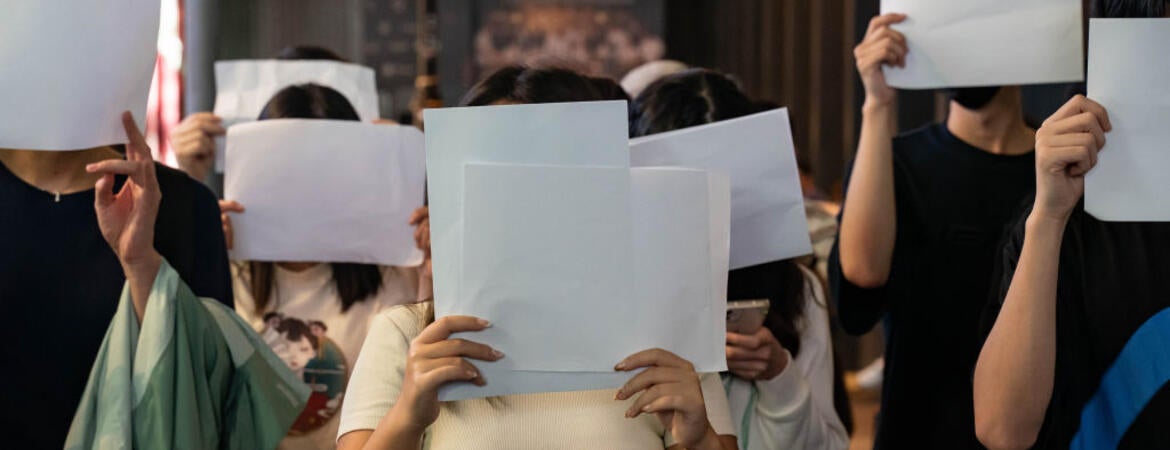
In wake of a renewed COVID-19 lockdown, Chinese citizens protested openly in the streets the past several days. It's a rare display in China, where civil unrest is historically greeted with harsh government recriminations. We asked UCR professors Perry Link and Rich Carpiano to weigh in. Link co-translated The Tiananmen Papers, related to the 1989 democracy protests. In response to his role in the translation, since 1996 he has been blacklisted by China. He is a board member of the Committee for Freedom in Hong Kong and taught Chinese language and literature at UCLA and Princeton University. Carpiano is a UC Riverside professor of public policy and sociology who specializes in public health and medical sociology, analyzing how social factors impact population health around the world.
Q: Why do the demonstrators hold up blank pieces of paper?
Link: It is a way of saying, "You know what I mean, and I know that you know what I mean; indeed everybody knows, so I don't need to say it." Beyond that, it is a defense mechanism. When you detain and interrogate me, there will be no words that you can pin on me. Singing songs serves the same purpose. Demonstrators sing China's national anthem, and of course that cannot be faulted, and yet the first line says, "Rise up, people who would not be slaves... the Chinese nation has reached its most dangerous hour..." Choral shouting of slogans works, too.
The phrases "Xi Jinping step down!" and "Communist Party step down" are dangerous in the extreme. A person can be sent to prison for years for uttering them in public. But chorally? One protester shouts, "Xi Jinping!" and a group responds with "Step down!" Then "Communist Party!" followed by "Step Down!" Note: No one involved said a complete sentence. This maneuver will not necessarily spare one punishment. But it will at least slow an interrogation down, and it might work.
Q: Has worldwide sympathy for a zero-COVID policy waned?
Carpiano: Indeed sympathy for such a policy has waned. Notably, the World Health Organization has stated that China's zero-COVID policy is unsustainable. Though China has been able to keep cases and deaths low relative to other nations, in general, a zero-COVID policy is viewed as unrealistic and unsustainable. This is because COVID-19 is now an endemic disease (especially given the infectiousness of the Omicron variant) we have the capacity to control, but not eradicate. Our efforts to control the spread of COVID-19 include a "toolkit" that includes many approaches, such as vaccinations, testing, proper air filtration in buildings, and accessible antiviral medications, as well as masking, social distancing, contact tracing apps, and isolation of those who are infected.
As part of its zero-COVID approach, China has relied heavily on instituting lockdowns. These can also be useful for mitigating a surge of new cases by preventing hospitals and other services from being overwhelmed while enabling public health systems to "buy time" in developing and mounting a coordinated response that includes actions like amassing necessary resources and staging mass vaccination campaigns. However, as we saw in the U.S. during the initial phase of the pandemic, a lockdown is a temporary measure. It is not sustainable for long durations... due to their societal impacts that severely limit daily, personal and work-related activities for large populations.
Q: Are the COVID-19 restrictions the reason for the protests, or a launching point to address larger concerns?
Link: Mao Zedong's Great Leap famine of 1959-62 and Cultural Revolution of 1966-69 were body-blows to Chinese cultural values that the country is still groping to recover from. Moral drift has continued into later generations, and people ever since have felt an uneasiness, a malaise. They want something better. Young people, their lives lying before them, are especially eager.
The COVID-19 restrictions, which have been harsh and authoritarian, have become the issue around which protests are organized, but the underlying discontent with strong-arm rule is broader and deeper. The deaths of 10 people in Urumqi because of a COVID lockdown have generated tremendous sympathy all across China, but not because people elsewhere know those 10 people or even know anything about Urumqi; they respond because the Urumqi events resonate with their own experiences. Their protests are a vicarious expression of anger and frustration at affronts to their own families, friends, and selves. And at a deeper level, it is a venting of long-festering malaise.
Q: Thus far, China’s response to protests has been (mostly) restrained. Should we expect that to change? Is there reason to believe the government’s response to the Tiananmen Square protests in 1989 may be repeated?
Link: The government's response has not been restrained. It is true that no tanks or machine guns have been deployed, as they were in 1989, but that's because the regime wants to keep the repression invisible if it can. Instead it is using plainclothes police to detain protesters one by one.
The government's vaunted Skynet system of street cameras, with its accompanying facial-recognition software, is by far the best in the world. Every protester must anticipate that sooner or later he or she will be found, interrogated, threatened, and, if none of that works, punished.
Tanks and machine guns will be used only if a large number of protesters (thousands or more) do a sit-in at one location, as happened at Tiananmen in 1989. Will that happen? I doubt it. But will Xi Jinping do a repression? There can be no question at all that he will. It has already begun.
Q: What role does China’s refusal to employ Western vaccines play into the population’s unrest?
Carpiano: China has relied on its own domestically-produced COVID-19 vaccines, which have been found to be less effective than COVID-19 vaccines used in North America and Europe — especially for protecting against the Omicron variant — and thus require three doses to offer comparable protection. It has not yet approved the use and distribution of foreign-produced vaccines for its citizens (only for foreigners living in China).
But beyond the effectiveness of China's vaccines, significant gaps remain in their vaccination coverage. Initially, China's vaccines were only offered to people under age 60, leaving out the oldest age groups that are most at-risk of harms from COVID-19. This decision generated concern among the public and some health care providers that the vaccines were unsafe for older persons and subsequently contributed to vaccine hesitancy when older people became eligible to receive COVID-19 vaccinations. Currently, the population ages 60 and older have low rates of receiving a third (booster) shot. Furthermore, with COVID-19 cases having been so low in China, many people have no natural immunity from a recent COVID infection nor hybrid immunity via vaccination and prior infection.



